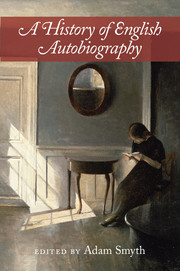Book contents
- Frontmatter
- Dedication
- Contents
- List of contributors
- 1 Introduction: The range, limits, and potentials of the form
- PART 1 AUTOBIOGRAPHY BEFORE ‘AUTOBIOGRAPHY’ (CA. 1300–1700)
- 2 Medieval life-writing: Types, encomia, exemplars, patterns
- 3 Autobiographical selves in the poetry of Chaucer, Gower, Hoccleve, and Lydgate
- 4 The radicalism of early modern spiritual autobiography
- 5 Inscribing the early modern self: The materiality of autobiography
- 6 Re-writing revolution: Life-writing in the Civil Wars
- 7 Money, accounting, and life-writing, 1600–1700: Balancing a life
- PART 2 RELIGION, GENDER, THINGS (CA. 1700–1800)
- PART 3 THE MANY NINETEENTH CENTURIES (CA. 1800–1900)
- PART 4 RELATIONAL LIVES AND FORMS OF REMEMBERING (CA. 1890–1930)
- PART 5 KINDS OF COMMUNITY (CA. 1930-CONTEMPORARY)
- Index
- References
2 - Medieval life-writing: Types, encomia, exemplars, patterns
from PART 1 - AUTOBIOGRAPHY BEFORE ‘AUTOBIOGRAPHY’ (CA. 1300–1700)
Published online by Cambridge University Press: 05 March 2016
- Frontmatter
- Dedication
- Contents
- List of contributors
- 1 Introduction: The range, limits, and potentials of the form
- PART 1 AUTOBIOGRAPHY BEFORE ‘AUTOBIOGRAPHY’ (CA. 1300–1700)
- 2 Medieval life-writing: Types, encomia, exemplars, patterns
- 3 Autobiographical selves in the poetry of Chaucer, Gower, Hoccleve, and Lydgate
- 4 The radicalism of early modern spiritual autobiography
- 5 Inscribing the early modern self: The materiality of autobiography
- 6 Re-writing revolution: Life-writing in the Civil Wars
- 7 Money, accounting, and life-writing, 1600–1700: Balancing a life
- PART 2 RELIGION, GENDER, THINGS (CA. 1700–1800)
- PART 3 THE MANY NINETEENTH CENTURIES (CA. 1800–1900)
- PART 4 RELATIONAL LIVES AND FORMS OF REMEMBERING (CA. 1890–1930)
- PART 5 KINDS OF COMMUNITY (CA. 1930-CONTEMPORARY)
- Index
- References
Summary
And in case things which should be remembered perish with time and vanish from the memory of those who are to come after us, I, seeing so many evils, and the whole world placed, as it were, within the grasp of the evil one – and being myself as if among the dead, waiting for death to visit me – have put into writing truthfully all the things that I have heard. And – lest the writing should perish with the writer, and the work fail with the labourer – I leave parchment to continue this work, if perchance any man survive, and any of the race of Adam escape this pestilence and carry on the work which I have begun.
(Butler 1849, 37)So writes John Clyn, a friar of Kilkenny, after the plague has left him all alone, the sole survivor of his brethren, and soon to succumb himself. This longing to leave behind at least some testimony that we ever existed may be universal, but it is a powerful part of the various forms of self-commemoration and self-fictionalisation through which an autobiographical impetus manifests itself across medieval English textual culture. It is high time to challenge the orthodoxy that the Middle Ages are irrelevant to understanding the evolution of those more recent autobiographical forms which so satisfyingly mirror back to us the complexity and subtlety of our modern selves. When the craft of life-writing was pursued so frequently and so perceptively as it was in the Middle Ages, it would seem intrinsically unlikely that – as is so often repeated – medieval authors regarded writing about the self as a profitless vanity and rarely did so. Auto(bio)graphy in medieval English texts is more an action than a form, an act of self-assertion, only exceptionally expressed through any extended narrative, which itself may appear discontinuous and bitty. But modes of auto(bio)graphical activity can be identified as subsumed and implicit, bubbling up across very different medieval genres, which poses the question whether medieval representations of selves in more fragmented forms – interstitial, implicit, in unnerving fusions of fact and self-fictionalisation – may not offer their own compellingly unillusioned readings of how far the self may be represented.
- Type
- Chapter
- Information
- A History of English Autobiography , pp. 13 - 26Publisher: Cambridge University PressPrint publication year: 2016



